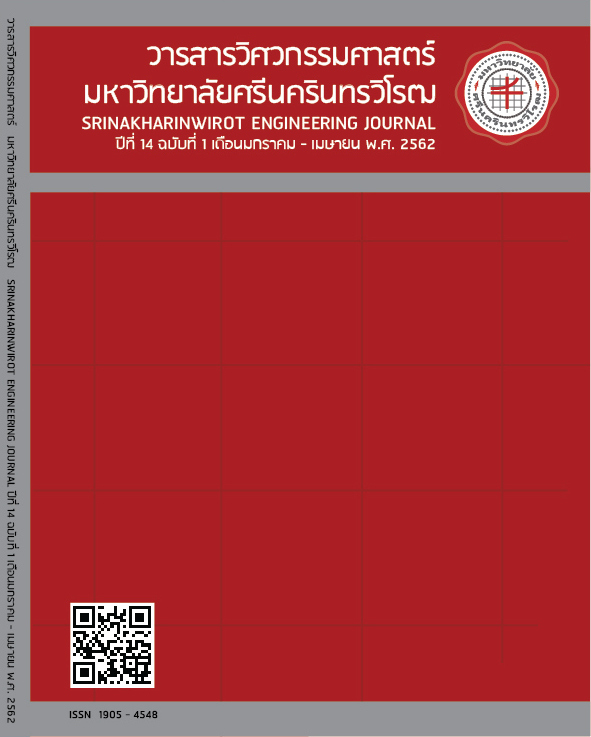The Configuration of Grate Affect to the Behavior of Airflow in the High Efficiency Cooking Stove
Main Article Content
Abstract
This research aims to study the configuration of grate affect to the behavior of airflow in the high efficiency cooking stove using computational fluid dynamics (CFD). This research defines the model mesh boundary condition from a previous study [11]. The analysis found that the temperature distribution is consistent with a previous study, by the mean error of 0.77%. Then make modify the configuration of grate such as number of holes, thickness and the diameter ratio of hole with different total 27 models to fine the best burning trend, based on the average speed. That is at low speed of airflow can improves times to mixing of air and fuel in the combustion chamber, thus burning up as a result and have a good trend of high thermal efficiency. From this study found that the best burning trend can be said that the number of grate holes is 44, thickness of grate is 30 mm and the diameter ratio of hole is 13:14 mm.
Article Details
Copyright belongs to Srinakharinwirot University Engineering Journal
References
[2] Aroon Chomcharn, “Improved biomass cooking stove for household use,” Report submitted to the National Energy Administration, Ministry of Science, Technology and Energy, Bangkok, 1984.
[3] ภานุวันทน์ คล้ายวงศ์วาลย์, “การทดสอบและปรับปรุงประสิทธิภาพเตาถ่าน,” วิทยานิพนธ์ปริญญาวิศวกรรมศาสตรมหาบัณฑิต, สาขาวิชาเทคโนโลยีการจัดการพลังงาน. มหาวิทยาลัยเทคโนโลยีพระจอมเกล้าธนบุรี, 2546.
[4] อนุรักษ์ หอสูงเนิน และ รัชพล สันติวรากร, “การศึกษาเปรียบเทียบประสิทธิภาพของเตาหุงต้มชนิดต่างๆ ที่ใช้ในครัวเรือน,” การประชุมวิชาการระดับชาติและนานาชาติ มหาวิทยาลัยขอนแก่น ประจำปี 2553 ในหัวข้อการพัฒนาชนบทที่ยั่งยืน ครั้งที่ 2, จังหวัดหนองคาย, 2553, หน้า 343-347.
[5] อภิสิทธิ์ พรมดอน และ ธนรัฐ ศรีวีระกุล, “การทดสอบประสิทธิภาพเชิงความร้อนของเตาหุงต้มประสิทธิภาพสูงเมื่อจำนวนและอัตราส่วนเส้นผ่านศูนย์กลางของรูรังผึ้งเปลี่ยนไป,” การประชุมวิชาการเครือข่ายวิศวกรรมเครื่องกลแห่งประเทศไทย ครั้งที่ 26, จังหวัดเชียงราย, 2555.
[6] สัญชัย รำเพยพัด, “การจำลองเชิงตัวเลขการไหลของอากาศในเตาเผาไหม้ชานอ้อย,” วิทยานิพนธ์ปริญญาวิศวกรรมศาสตรมหาบัณฑิต, สาขาวิชาวิศวกรรมเครื่องกล. มหาวิทยาลัยขอนแก่น, 2547.
[7] Burnham-Slipper, “Breeding a better stove: the use of computation fluid dynamics and genetic algorithms to optimize a wood burning stove for Eritrea,” Ph.D.’s Thesis, The University of Nottingham, 2008.
[8] มานะ วิชางาม และ ธนรัฐ ศรีวีระกุล, “การจำลองการไหลของอากาศผ่านรูรังผึ้งเตาหุงต้มประสิทธิภาพสูงโดยใช้โปรแกรม CFD,” วารสารวิทยาศาสตร์และเทคโนโลยี มหาวิทยาลัยอุบลราชธานี, ปีที่ 14, ฉบับที่ 2, หน้า 24-34,เมษายน–มิถุนายน 2555.
[9] มานะ วิชางาม และ ธนรัฐ ศรีวีระกุล, “การจำลองพลศาสตร์ของไหลเชิงคำนวณกับการไหลของอากาศในเตาหุงต้มประสิทธิภาพสูง เมื่อเลือกใช้แบบจำลองการแผ่รังสีความร้อนที่ต่างกัน 2 รูปแบบ,” การประชุมวิชาการเครือข่ายพลังงานแห่งประเทศไทยครั้งที่ 8, จังหวัดมหาสารคาม, 2555.
[10] M. Wichangarm, T. Sriveerakul and S. Aphornratana, “Numerical simulation of airflow in the high efficiency cooking stove,” The 4th KKU International Engineering Conference 2012, Khonkaen, Thailand, 2012 pp. 10–12.
[11] ธนรัฐ ศรีวีระกุล, มานะ วิชางาม และ ณรงค์ศักดิ์ ปิยะไพร, “การทำนายพฤติกรรมการไหลของอากาศภายในเตาหุงต้มประสิทธิภาพสูง,” การประชุมวิชาการเครือข่ายวิศวกรรมเครื่องกลแห่งประเทศไทย ครั้งที่ 29, จังหวัดนครราชสีมา, 2558, หน้า 619-626.
[12] H. Ali and T. T. J. Wei, “CFD study of an improved biomass cookstove with reduced emission and improved heat transfer characteristics,” Journal of Clean Energy Technologies, vol. 5, no. 6, pp. 427-432, November 2017.


